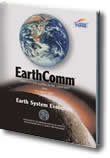The module, Earth System Evolution leads students to an understanding of changes in the earth system that have created the present physical environment and the evolution of life using a student based inquiry approach. The module consists of three chapters: Astronomy, Climate Change, and Changing Life. The chapters lead students from an understanding of the formation of our planet and its role as a subsystem in a dynamic universe, to an examination of the relationships between the physical environment and climate through time, and finally to an understanding of how and why the organisms found in their community have changed over time.
Themes
Through their inquiry in this module, students develop understandings of the evolution of Earth’s systems. The major themes addressed include the following portions of the National Science Education Standards for Grades 9-12:
- Earth is a part of the solar system, which in turn is part of the galaxy, and on a larger scale, the universe.
- Earth’s external energy depends on varying factors, including distance from the sun, solar variability, and gravitational forces.
- The Earth’s physical environment includes land masses, atmosphere, and oceans, which have all contributed to its formation and continued changes.
- Fossil evidence has shown how organisms have evolved from ancient environments and continue to change as our environment evolves.
Astronomy and Your Community
This chapter gives students a feeling of their place as a member of not only of their local community, but also of the Earth community, the solar system, and the universe. In Astronomy and Your Community, students are presented with a hypothetical situation in which an asteroid is predicted to pass very close to Earth. Students are asked to prepare a booklet for their community that discusses some of the possible hazards from outer space and the benefits of living in our solar system. Students begin the chapter by putting the scale of the solar system into perspective and learning how our solar system formed. Students then examine the relationship between the Earth and Moon and the Earth and Sun. Students investigate how an asteroid collision would affect their community. Finally, students examine Earth’s place within the Milky Way galaxy. By the end of the chapter, students understand the history and size of our planetary community, and how processes and events that occur within the solar system influence the Earth, and what the chances are of those events happening.
Climate Change and Your Community
The Chapter Challenge for Climate Change and Your Community is for students to write a series of newspaper articles that explore global climate change. As students move through the chapter, they gain the knowledge needed to write articles concerning how global climate has changed over time, what causes global climate change, and the meaning of “global warming” and how it might affect their community. Finally, students are asked to use the knowledge they have acquired to write an editorial piece that states whether or not their community should be concerned about global warming, and what steps the community should take in response to the possibility of global warming.
Changing Life and Your Community
In this chapter, students are challenged to produce a display that illustrates the biological changes that their community has experienced over several years of geologic time. Students begin the chapter by exploring the process of fossilization and determining which organism in their community are most likely to be preserved in the fossil record. Students look at how climate influences the types of organisms found in a specific place. Students use this information to hypothesize about how organisms in their community might have differed 20,000 years ago, when glaciers covered portions of North America. Extinction events and how they fit into the evolutionary scheme are explored. Finally, students investigate how their community has changed throughout geologic time, and what effect this might have had on the types of organisms found in their community.

